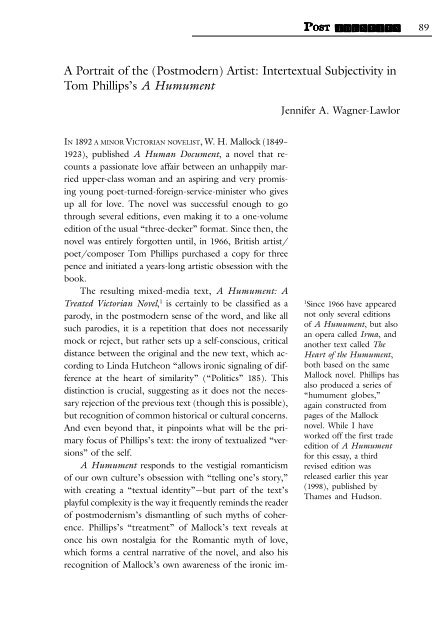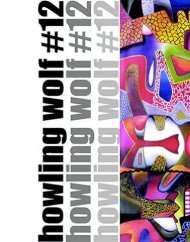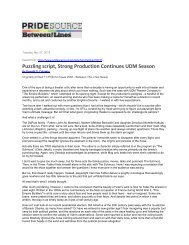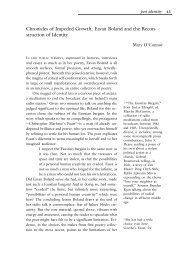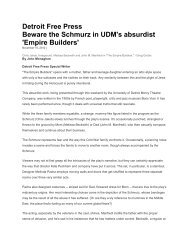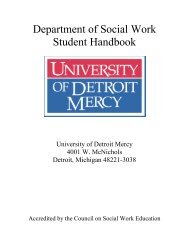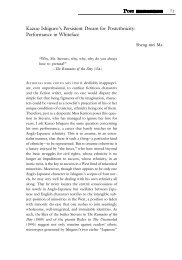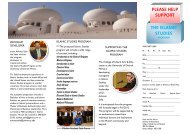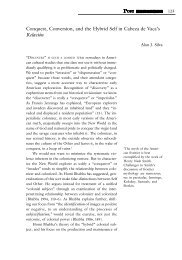A Portrait of the (Postmodern) Artist: Intertextual Subjectivity in Tom ...
A Portrait of the (Postmodern) Artist: Intertextual Subjectivity in Tom ...
A Portrait of the (Postmodern) Artist: Intertextual Subjectivity in Tom ...
You also want an ePaper? Increase the reach of your titles
YUMPU automatically turns print PDFs into web optimized ePapers that Google loves.
IN 1892 A MINOR VICTORIAN NOVELIST, W. H. Mallock (1849–<br />
1923), published A Human Document, a novel that recounts<br />
a passionate love affair between an unhappily married<br />
upper-class woman and an aspir<strong>in</strong>g and very promis<strong>in</strong>g<br />
young poet-turned-foreign-service-m<strong>in</strong>ister who gives<br />
up all for love. The novel was successful enough to go<br />
through several editions, even mak<strong>in</strong>g it to a one-volume<br />
edition <strong>of</strong> <strong>the</strong> usual “three-decker” format. S<strong>in</strong>ce <strong>the</strong>n, <strong>the</strong><br />
novel was entirely forgotten until, <strong>in</strong> 1966, British artist/<br />
poet/composer <strong>Tom</strong> Phillips purchased a copy for three<br />
pence and <strong>in</strong>itiated a years-long artistic obsession with <strong>the</strong><br />
book.<br />
The result<strong>in</strong>g mixed-media text, A Humument: A<br />
Treated Victorian Novel, 1 is certa<strong>in</strong>ly to be classified as a<br />
parody, <strong>in</strong> <strong>the</strong> postmodern sense <strong>of</strong> <strong>the</strong> word, and like all<br />
such parodies, it is a repetition that does not necessarily<br />
mock or reject, but ra<strong>the</strong>r sets up a self-conscious, critical<br />
distance between <strong>the</strong> orig<strong>in</strong>al and <strong>the</strong> new text, which accord<strong>in</strong>g<br />
to L<strong>in</strong>da Hutcheon “allows ironic signal<strong>in</strong>g <strong>of</strong> difference<br />
at <strong>the</strong> heart <strong>of</strong> similarity” (“Politics” 185). This<br />
dist<strong>in</strong>ction is crucial, suggest<strong>in</strong>g as it does not <strong>the</strong> necessary<br />
rejection <strong>of</strong> <strong>the</strong> previous text (though this is possible),<br />
but recognition <strong>of</strong> common historical or cultural concerns.<br />
And even beyond that, it p<strong>in</strong>po<strong>in</strong>ts what will be <strong>the</strong> primary<br />
focus <strong>of</strong> Phillips’s text: <strong>the</strong> irony <strong>of</strong> textualized “versions”<br />
<strong>of</strong> <strong>the</strong> self.<br />
A Humument responds to <strong>the</strong> vestigial romanticism<br />
<strong>of</strong> our own culture’s obsession with “tell<strong>in</strong>g one’s story,”<br />
with creat<strong>in</strong>g a “textual identity”—but part <strong>of</strong> <strong>the</strong> text’s<br />
playful complexity is <strong>the</strong> way it frequently rem<strong>in</strong>ds <strong>the</strong> reader<br />
<strong>of</strong> postmodernism’s dismantl<strong>in</strong>g <strong>of</strong> such myths <strong>of</strong> coherence.<br />
Phillips’s “treatment” <strong>of</strong> Mallock’s text reveals at<br />
once his own nostalgia for <strong>the</strong> Romantic myth <strong>of</strong> love,<br />
which forms a central narrative <strong>of</strong> <strong>the</strong> novel, and also his<br />
recognition <strong>of</strong> Mallock’s own awareness <strong>of</strong> <strong>the</strong> ironic im-<br />
POST OST IDENTITY IDENTITY 89<br />
A <strong>Portrait</strong> <strong>of</strong> <strong>the</strong> (<strong>Postmodern</strong>) <strong>Artist</strong>: <strong>Intertextual</strong> <strong>Subjectivity</strong> <strong>in</strong><br />
<strong>Tom</strong> Phillips’s A Humument<br />
Jennifer A. Wagner-Lawlor<br />
1 S<strong>in</strong>ce 1966 have appeared<br />
not only several editions<br />
<strong>of</strong> A Humument, but also<br />
an opera called Irma, and<br />
ano<strong>the</strong>r text called The<br />
Heart <strong>of</strong> <strong>the</strong> Humument,<br />
both based on <strong>the</strong> same<br />
Mallock novel. Phillips has<br />
also produced a series <strong>of</strong><br />
“humument globes,”<br />
aga<strong>in</strong> constructed from<br />
pages <strong>of</strong> <strong>the</strong> Mallock<br />
novel. While I have<br />
worked <strong>of</strong>f <strong>the</strong> first trade<br />
edition <strong>of</strong> A Humument<br />
for this essay, a third<br />
revised edition was<br />
released earlier this year<br />
(1998), published by<br />
Thames and Hudson.
90 POST OST IDENTITY<br />
IDENTITY<br />
2 I borrow this term from<br />
Susan Wolfson’s Formal<br />
Charges, whose chapter on<br />
Wordsworth’s poetical<br />
autobiography, The<br />
Prelude, provides useful<br />
avenues <strong>of</strong> thought<br />
regard<strong>in</strong>g autobiography<br />
as a genre. The quotation<br />
comes from p. 27.<br />
3 Phillips has noted that <strong>the</strong><br />
work is also deliberately<br />
modeled on Francesco<br />
Colonna’s Hypnerotomachia<br />
Polophili, “<strong>the</strong> most beautiful<br />
<strong>of</strong> pr<strong>in</strong>ted books,<br />
published <strong>in</strong> Venice <strong>in</strong><br />
1499” (“Notes,” A<br />
Humument, n.p.), and<br />
<strong>in</strong>fluenced as well by<br />
medieval illum<strong>in</strong>ated<br />
manuscripts.<br />
4 A Humument, n.p.<br />
possibility <strong>of</strong> both that myth and, relatedly, <strong>the</strong> myth <strong>of</strong><br />
<strong>the</strong> unified self. Indeed, Phillips will expose what is most<br />
surpris<strong>in</strong>gly modern <strong>in</strong> Mallock’s text: its “discursive selfconsciousness”<br />
(McHale 165), <strong>the</strong> awareness that subjectivity<br />
is itself textual, historically cont<strong>in</strong>gent, and openended.<br />
This portrait <strong>of</strong> an artist does more than explore, via<br />
its appropriation <strong>of</strong> <strong>the</strong> Mallock text, <strong>the</strong> irony that <strong>in</strong>herently<br />
destabilizes <strong>the</strong> myth <strong>of</strong> a unified self. Phillips’s parody<br />
br<strong>in</strong>gs forward a “textual I” whose identity is no longer<br />
bound by any simple notion <strong>of</strong> textuality; A Humument<br />
celebrates a postmodern self-fashion<strong>in</strong>g <strong>of</strong> <strong>the</strong> “self-as-artist,”<br />
a figure whose identity is <strong>in</strong>tertextually dynamic, whose<br />
life’s text is endlessly transform<strong>in</strong>g. The text, which Huston<br />
Paschal calls “a laconic journal <strong>of</strong> <strong>the</strong> artist’s personal life”<br />
(17), is at once fictional and autobiographical, fundamentally<br />
anti-formalist, yet also fasc<strong>in</strong>ated by <strong>the</strong> way that identity<br />
or, more accurately perhaps, subjectivity is both constituted<br />
and “made legible” 2 by language, by form, by Art.<br />
I<br />
A Humument is palimpsestically <strong>in</strong>tertextual. It is <strong>in</strong> a quite<br />
literal sense a revision <strong>of</strong> <strong>the</strong> novel A Human Document. 3<br />
Phillips worked his text upon actual leaves <strong>of</strong> editions <strong>of</strong><br />
<strong>the</strong> 1892 edition; as his work on this subject has cont<strong>in</strong>ued,<br />
he has bought up every copy <strong>of</strong> <strong>the</strong> novel that he and<br />
his friends have been able to put <strong>the</strong>ir hands on. The book,<br />
a sort <strong>of</strong> poetical novel, is “treated,” as Phillips puts it, on<br />
a literal level through his highlight<strong>in</strong>g <strong>of</strong> str<strong>in</strong>gs <strong>of</strong> <strong>the</strong> orig<strong>in</strong>al<br />
text (Fig. 1) by <strong>in</strong>scrib<strong>in</strong>g connected “bubbles” around<br />
groups <strong>of</strong> words or letters; he describes <strong>the</strong> look <strong>of</strong> <strong>the</strong><br />
“new” text on <strong>the</strong> page as “rivers <strong>of</strong> type,” 4 flow<strong>in</strong>g as<br />
<strong>the</strong>y do from l<strong>in</strong>e to l<strong>in</strong>e. The rest <strong>of</strong> <strong>the</strong> orig<strong>in</strong>al text is<br />
ei<strong>the</strong>r obscured completely—by a draw<strong>in</strong>g or design applied<br />
on top (a k<strong>in</strong>d <strong>of</strong> modern “illum<strong>in</strong>ation,” <strong>in</strong> o<strong>the</strong>r<br />
words), by erasure or effacement <strong>of</strong> some sort, or by be<strong>in</strong>g<br />
simply cut out. Just as <strong>of</strong>ten though it is allowed to “ghost<br />
through” as a legible (or almost legible) graphic background<br />
to <strong>the</strong> highlighted type. This text is highly “textured,”<br />
layered, <strong>the</strong> orig<strong>in</strong>al text sometimes entirely submerged,<br />
sometimes subtly emerg<strong>in</strong>g, sometimes jutt<strong>in</strong>g through <strong>the</strong><br />
Jennifer A. Wagner-Lawlor
surface <strong>of</strong> <strong>the</strong> new text. This emphasizes both <strong>the</strong> materiality<br />
<strong>of</strong> <strong>the</strong> text itself—both Mallock’s and his own—and<br />
also its historicity, its simultaneous access to both past and<br />
present.<br />
The historicity <strong>of</strong> <strong>the</strong> Phillips narrative is highlighted<br />
by <strong>the</strong> very form that A Humument takes. This is evident<br />
from <strong>the</strong> open<strong>in</strong>g page, <strong>the</strong> very title created by cutt<strong>in</strong>g<br />
out <strong>the</strong> middle syllables <strong>of</strong> <strong>the</strong> Mallock title, and past<strong>in</strong>g<br />
<strong>the</strong> fragmented words toge<strong>the</strong>r. These techniques create<br />
immediately complex dynamics between <strong>the</strong> old narrative<br />
and <strong>the</strong> new, whereby <strong>the</strong> orig<strong>in</strong>al text becomes at once<br />
pretext and image, a “visible language,” <strong>in</strong> W. J. T.<br />
Mitchell’s sense, whereby <strong>the</strong> “graphic potential” <strong>of</strong> a text<br />
is fulfilled, its “sensuous surface <strong>of</strong> <strong>the</strong> calligraphic and<br />
typographic forms” suggest<strong>in</strong>g “symbolic values” (“Visible<br />
Language” 83–4). 5 Indeed, <strong>in</strong> its effacement by pa<strong>in</strong>t,<br />
<strong>in</strong>k, watercolor, scratch<strong>in</strong>g, erasure, it becomes a self-reflexive<br />
image <strong>of</strong> <strong>the</strong> historical nature <strong>of</strong> <strong>the</strong> <strong>in</strong>tertextual<br />
enterprise. The text is artifact. This text highlights not<br />
merely <strong>in</strong>escapability <strong>of</strong> that past, but its very <strong>in</strong>stability:<br />
both past and present are <strong>in</strong>volved <strong>in</strong> ever-shift<strong>in</strong>g contexts<br />
that revise both. Return<strong>in</strong>g to <strong>the</strong> title once more:<br />
<strong>the</strong> word humument carries with it <strong>the</strong> sense <strong>of</strong> an “unearth<strong>in</strong>g”<br />
<strong>of</strong> <strong>the</strong> past; <strong>the</strong> neologism echoes <strong>of</strong> <strong>the</strong> “human,”<br />
<strong>the</strong> earthy “humus,” <strong>the</strong> posthumous and “monument”-al.<br />
6<br />
Phillips’s text <strong>in</strong>deed f<strong>in</strong>ds its subject (<strong>the</strong> textual/sexual<br />
self) and its modus operandi (<strong>the</strong> composite artistry<br />
<strong>of</strong> a k<strong>in</strong>d <strong>of</strong> textual archaeology) <strong>in</strong> <strong>the</strong> orig<strong>in</strong>al text itself.<br />
For Mallock’s A Human Document is a framed narrative,<br />
itself a reconstruction, by a narrator/editor, <strong>of</strong> handeddown<br />
or -over diaries, letters, souvenirs and o<strong>the</strong>r textual<br />
“rema<strong>in</strong>s” <strong>of</strong> a pair <strong>of</strong> lovers’ lives. The narrator attempts a<br />
coherent narrative <strong>of</strong> <strong>the</strong> love affair that <strong>the</strong> female lover <strong>in</strong><br />
particular, “Irma,” regarded as <strong>the</strong> only “au<strong>the</strong>ntic” experience<br />
<strong>of</strong> her life. While <strong>the</strong> editor acknowledges that certa<strong>in</strong><br />
changes were made (such as names, places), he remarks<br />
<strong>in</strong> <strong>the</strong> clos<strong>in</strong>g pages <strong>of</strong> <strong>the</strong> preface, “I can say <strong>of</strong> it at<br />
least one th<strong>in</strong>g with confidence, even if it is not a piece <strong>of</strong><br />
literature, it is a piece <strong>of</strong> life: it is genu<strong>in</strong>ely a human document”<br />
(I.24). His handl<strong>in</strong>g <strong>of</strong> <strong>the</strong> narrative and <strong>the</strong> very<br />
Jennifer A. Wagner-Lawlor<br />
POST OST IDENTITY IDENTITY 91<br />
5 On Mitchell’s exploration<br />
<strong>of</strong> “composite art,”<br />
“visible language” and <strong>the</strong><br />
“imagetext,” see his<br />
several groundbreak<strong>in</strong>g<br />
books, Blake’s Composite<br />
Art (1978), Iconology<br />
(1986), and Picture Theory<br />
(1994), especially, <strong>in</strong> <strong>the</strong><br />
latter, chapters 3, 4, and 8<br />
(83–150, 241–79).<br />
6 Marv<strong>in</strong> A. Sackner,<br />
Phillips’s primary private<br />
collector and co-founder<br />
<strong>of</strong> <strong>the</strong> Ruth and Marv<strong>in</strong><br />
Sackner Archive <strong>of</strong><br />
Concrete and Visual<br />
Poetry, also associates <strong>the</strong><br />
title word with “<strong>the</strong> idea<br />
<strong>of</strong> Humanism, which <strong>the</strong><br />
German philosopher<br />
Schiller emphasised as <strong>the</strong><br />
idea <strong>of</strong> <strong>the</strong> creative<br />
<strong>in</strong>dividual thought<br />
form<strong>in</strong>g <strong>the</strong> basis <strong>of</strong><br />
personal truth”<br />
(“Humumentism,” n.p.).
92 POST OST IDENTITY<br />
IDENTITY<br />
7 For a rare discussion <strong>of</strong><br />
<strong>the</strong> Mallock text <strong>in</strong><br />
relation to Phillips, see<br />
Daniel Traister, “W. H.<br />
Mallock, and A Human<br />
Document” on <strong>the</strong> <strong>Tom</strong><br />
Phillips Homepage.<br />
Traister also connects<br />
Phillips’s collage method<br />
to A Human Document’s<br />
own concern with<br />
fragmented texts and<br />
artifacts.<br />
tone <strong>of</strong> <strong>the</strong> writ<strong>in</strong>g is shadowed by <strong>the</strong> posthumous nature<br />
<strong>of</strong> <strong>the</strong> experience it describes, both lovers now be<strong>in</strong>g deceased.<br />
The Mallock preface, <strong>the</strong>n, is self-consciously and<br />
fully aware <strong>of</strong> <strong>the</strong> ironies <strong>of</strong> <strong>the</strong> situation it sets up, and <strong>the</strong><br />
metaphorics <strong>of</strong> textuality pervade <strong>the</strong> novel. 7 But beyond<br />
that—and more crucially for sett<strong>in</strong>g up <strong>the</strong> ma<strong>in</strong> focus <strong>of</strong><br />
<strong>the</strong> Phillips text—is how <strong>the</strong> Mallock novel recognizes that<br />
identity itself is only precariously revealed by any text.<br />
The relationship between phenomenal experience and<br />
textual representation is underm<strong>in</strong>ed at every turn <strong>in</strong><br />
Mallock’s text, but is specifically exploited <strong>in</strong> Phillips’s.<br />
Irma’s diary <strong>in</strong> particular is a way not simply <strong>of</strong> record<strong>in</strong>g<br />
events <strong>of</strong> her life, but <strong>of</strong> actually “experienc<strong>in</strong>g” her life:<br />
“Who am I? What am I?” Irma writes at <strong>the</strong> open<strong>in</strong>g <strong>of</strong><br />
her diary. “I am nobody, and less than noth<strong>in</strong>g. I am not<br />
even one <strong>of</strong> my own few possibilities” (II.10). Her sense <strong>of</strong><br />
herself at this po<strong>in</strong>t is strangely posthumous, as if life has<br />
already passed by her entirely. A once imag<strong>in</strong>ative young<br />
woman who acquiesced to an arranged and loveless marriage,<br />
she regards herself as a cipher, signify<strong>in</strong>g noth<strong>in</strong>g.<br />
For that very reason <strong>the</strong> <strong>in</strong>scription <strong>of</strong> <strong>the</strong> self-as-past becomes<br />
crucial for her: while she regards her narration as a<br />
“confession” for not hav<strong>in</strong>g experienced and “lived,” she<br />
also <strong>in</strong>sists that her life must have mean<strong>in</strong>g, and she will<br />
use this diary as a history to discover and reveal that mean<strong>in</strong>g.<br />
In do<strong>in</strong>g this, <strong>in</strong> <strong>in</strong>sist<strong>in</strong>g on a self-as-past, she beg<strong>in</strong>s<br />
impos<strong>in</strong>g a coherence that will create a sense <strong>of</strong> identity,<br />
and allow her to realize that she is “liv<strong>in</strong>g” for <strong>the</strong> first<br />
time. The diary will concern itself primarily, she writes,<br />
with “<strong>the</strong> pronoun ‘I’” (II.11). See<strong>in</strong>g herself as “like a<br />
book” (II.24), she regards her real life as actually beg<strong>in</strong>n<strong>in</strong>g<br />
with <strong>the</strong> diary itself, begun just as she meets her lover,<br />
such that <strong>in</strong> <strong>the</strong> midst <strong>of</strong> it she would write, “‘Every day <strong>of</strong><br />
my life is like a page out <strong>of</strong> an illum<strong>in</strong>ated missal’” (II.161).<br />
The <strong>in</strong>significant cipher—that “I” empty <strong>of</strong> any real experience—is,<br />
she discovers, a hidden self that writ<strong>in</strong>g itself<br />
releases <strong>in</strong>to life.<br />
The graphic traces <strong>of</strong> this self-discovery become <strong>Tom</strong><br />
Phillips’s own self-discovery through <strong>the</strong> Mallock pretext,<br />
<strong>the</strong> lovers’ text metamorphosed <strong>in</strong>to his own, <strong>in</strong>corporat<strong>in</strong>g<br />
<strong>the</strong>ir actual language as well as <strong>the</strong>ir figuration <strong>of</strong> <strong>the</strong>ir<br />
Jennifer A. Wagner-Lawlor
love affair as a k<strong>in</strong>d <strong>of</strong> “fairy tale” (Sleep<strong>in</strong>g Beauty is <strong>the</strong><br />
one most referred to) or “romance.” Like <strong>the</strong> Mallock lovers,<br />
who see <strong>the</strong>ir true identities emerge through a love<br />
that is mediated cont<strong>in</strong>ually by language, <strong>the</strong> double-heroes<br />
<strong>of</strong> this text, “<strong>Tom</strong>/Toge,” construct an identity that<br />
f<strong>in</strong>ds itself through both art and language’s mediation <strong>of</strong><br />
experience. But just as <strong>the</strong> Mallock lovers recognize <strong>the</strong><br />
unreality <strong>of</strong> this idealized position as just a “dream” from<br />
which reality cont<strong>in</strong>ually awakens <strong>the</strong>m, <strong>the</strong> “<strong>Tom</strong>/Toge”<br />
narrator(s) <strong>of</strong> <strong>the</strong> Phillips text recognize <strong>the</strong>ir location at a<br />
site between imag<strong>in</strong>ation and reality. “Identity,” as a negotiation<br />
<strong>of</strong> experience and reflection, is Mallock’s deepest<br />
subject <strong>in</strong> <strong>the</strong> 1892 novel. It is also Phillips’s, as he constructs<br />
<strong>the</strong> first <strong>of</strong> his explicitly autobiographical, if still<br />
semi-fictional, epics.<br />
II<br />
A Humument immediately takes on a life <strong>of</strong> its own that<br />
seems to leave its Victorian ancestor far beh<strong>in</strong>d. But as I<br />
have already suggested Phillips has taken a great deal from<br />
<strong>the</strong> Mallock text: <strong>the</strong> diary mode; <strong>the</strong> obsession with “I”<br />
and <strong>the</strong> development <strong>of</strong> a self-aware subject; <strong>the</strong> romance<br />
plot; <strong>the</strong> related conflict between reality and imag<strong>in</strong>ation,<br />
“translated” <strong>in</strong> <strong>the</strong> Phillips text <strong>in</strong>to a question <strong>of</strong> <strong>the</strong> relationship<br />
between reality and Art. Phillips speaks for “himself”<br />
<strong>in</strong> this loosely autobiographical text—that is, <strong>the</strong>re is<br />
no separate narrator; but Phillips does <strong>in</strong>troduce a new<br />
character, named “Bill Toge,” who takes up <strong>the</strong> romance<br />
plot, primarily, search<strong>in</strong>g for love from his “Irma.” And it<br />
becomes clear, particularly as both “<strong>Tom</strong>” and “Toge”<br />
refer to <strong>the</strong>mselves as “I,” that Toge is an alter ego—Bill<br />
Hurrell calls him <strong>the</strong> “everyman alter ego” (n.p.) <strong>of</strong> <strong>Tom</strong><br />
himself. Phillips po<strong>in</strong>ts out that Toge’s name can only appear<br />
on pages on which <strong>the</strong> words toge<strong>the</strong>r or altoge<strong>the</strong>r<br />
appear, thus l<strong>in</strong>guistically signall<strong>in</strong>g <strong>the</strong> connection between<br />
<strong>Tom</strong> and his alter ego. Fur<strong>the</strong>rmore, notes Phillips, Toge<br />
“also has his own recurrent iconography,” “a carpet and a<br />
w<strong>in</strong>dow look<strong>in</strong>g out onto a forest and his amoeba-like everchang<strong>in</strong>g<br />
shape is always constructed from <strong>the</strong> rivers <strong>in</strong> <strong>the</strong><br />
type” (“Notes,” first revised edition, n.p.; see Fig. 1, from<br />
A Humument 155).<br />
Jennifer A. Wagner-Lawlor<br />
POST OST IDENTITY IDENTITY 93
94 POST OST IDENTITY<br />
IDENTITY<br />
Fig. 1<br />
This description is an apt reflection <strong>of</strong> Phillips’s<br />
<strong>in</strong>tertextual playfulness, s<strong>in</strong>ce <strong>the</strong> w<strong>in</strong>dow motif is one that<br />
Phillips would employ elsewhere <strong>in</strong> his own work, namely,<br />
<strong>in</strong> his illustration <strong>of</strong> Dante’s Inferno, and <strong>in</strong> Curriculum<br />
Vitae. Paschal calls <strong>the</strong> w<strong>in</strong>dow motif a “rov<strong>in</strong>g talisman”<br />
throughout Phillips’s art,<br />
that symbolizes <strong>the</strong> “outlet<br />
for <strong>the</strong> artist’s imag<strong>in</strong>ation”<br />
(21); <strong>in</strong> o<strong>the</strong>r words,<br />
<strong>the</strong> w<strong>in</strong>dow becomes a selfreflexive<br />
symbol <strong>of</strong> <strong>the</strong><br />
artist’s formaliz<strong>in</strong>g activity.<br />
The w<strong>in</strong>dow is at once <strong>the</strong><br />
medium through which reality<br />
is viewed, and also <strong>the</strong><br />
“artistic frame” through<br />
which <strong>the</strong> artist’s own vision<br />
<strong>of</strong> his experience is<br />
revealed. In a paradoxical<br />
play with this image is<br />
Phillips’s description <strong>of</strong> <strong>the</strong><br />
“ever-chang<strong>in</strong>g shape” <strong>of</strong><br />
Toge. It po<strong>in</strong>ts precisely to <strong>the</strong> k<strong>in</strong>d <strong>of</strong> anti-formalism or<br />
postmodern frame-break<strong>in</strong>g that Phillips <strong>in</strong>sists upon.<br />
What energizes <strong>Tom</strong> Phillips’s A Humument as parody<br />
is its acknowledgment <strong>of</strong> and play amongst <strong>the</strong> various<br />
ironies <strong>of</strong> identity and textuality (identity-as-textuality) <strong>of</strong><br />
<strong>the</strong> Mallock novel. The matters <strong>of</strong> “au<strong>the</strong>nticity” <strong>of</strong> narrative,<br />
<strong>of</strong> experience, <strong>of</strong> identity, <strong>of</strong> <strong>the</strong> keenly desired but<br />
impossible “endless moment” that fuses self and O<strong>the</strong>r,<br />
become not <strong>the</strong> underm<strong>in</strong><strong>in</strong>g elements <strong>of</strong> ano<strong>the</strong>r<br />
postromantic narrative, but <strong>the</strong> very motivat<strong>in</strong>g elements<br />
<strong>of</strong> a postmodern one that revels <strong>in</strong> Irony itself. A Humument<br />
refers to itself as “a volume perplex” (6)—that adjective<br />
referr<strong>in</strong>g not to confusion or mental muddle, but <strong>in</strong>stead<br />
to a more etymologically based sense <strong>of</strong> <strong>in</strong>terwoven <strong>in</strong>tricacy,<br />
entanglement, <strong>in</strong>volution (per + plex, from L. ‘to plait,<br />
<strong>in</strong>terweave’). Phillips’s novel is self-consciously and selfreflexively<br />
founded precisely with<strong>in</strong> <strong>the</strong> ironies that darken<br />
romantic desire <strong>in</strong> <strong>the</strong> Mallock text; and it not only operates<br />
with<strong>in</strong> an overtly discursive context, but also celebrates<br />
Jennifer A. Wagner-Lawlor
that context’s radical openness.<br />
Like <strong>the</strong> Mallock text, Phillips’s is most fundamentally<br />
<strong>in</strong>terested <strong>in</strong> “<strong>the</strong> pronoun ‘I’”—and is <strong>the</strong>refore, like its<br />
pretext, a k<strong>in</strong>d <strong>of</strong> diary. Indeed, A Humument is someth<strong>in</strong>g<br />
like Wordsworth’s Prelude, 8 a poetical and graphic<br />
epic <strong>in</strong> which <strong>the</strong> subject<br />
is noth<strong>in</strong>g less than <strong>the</strong><br />
development <strong>of</strong> <strong>the</strong><br />
artist’s m<strong>in</strong>d, and, <strong>in</strong>deed<br />
<strong>the</strong> self-as-<strong>Artist</strong>: “The<br />
follow<strong>in</strong>g s<strong>in</strong>g I a book,”<br />
opens Phillips’s <strong>in</strong> an epic<br />
mode, “a book <strong>of</strong> art <strong>of</strong><br />
m<strong>in</strong>d art and that which<br />
he hid reveal I” reads <strong>the</strong><br />
river <strong>of</strong> type on page 1<br />
(Fig. 2). In that last<br />
phrase, he follows <strong>the</strong><br />
epic tradition <strong>of</strong> claim<strong>in</strong>g<br />
<strong>the</strong> superiority <strong>of</strong> his<br />
story to his predecessor’s<br />
—“and that which he hid reveal I”—though Phillips’s<br />
postmodern sensibilities will shade epic high-seriousness<br />
to mock-epic self-irony before too long.<br />
Unlike Mallock’s monumentalization <strong>of</strong> <strong>the</strong> reticence<br />
<strong>of</strong> any text, <strong>in</strong> and under which <strong>the</strong> “real self” or <strong>the</strong> genu<strong>in</strong>e<br />
life rema<strong>in</strong>s hidden, Phillips’s text employs as many<br />
techniques as possible <strong>in</strong> order to leave noth<strong>in</strong>g uncovered.<br />
A Humument is, as Phillips describes his work generally,<br />
research conducted <strong>in</strong> <strong>the</strong> labyr<strong>in</strong>th<strong>in</strong>e house <strong>of</strong><br />
memory <strong>of</strong> one’s own m<strong>in</strong>d: As I sieved through<br />
my past I found that <strong>the</strong> seeds <strong>of</strong> all that obsesses<br />
and concerns me <strong>in</strong> my art and life were all sown<br />
much earlier than I had guessed. (<strong>Portrait</strong> Works<br />
78)<br />
That “labyr<strong>in</strong>th<strong>in</strong>e house <strong>of</strong> memory”—an image no doubt<br />
witt<strong>in</strong>gly borrowed from Wordsworth and <strong>the</strong>n Keats—is<br />
an archival museum <strong>of</strong> experiential as well as textual traces,<br />
<strong>the</strong> contents <strong>of</strong> which are displayed throughout this work;<br />
not surpris<strong>in</strong>gly from an artist so <strong>in</strong>terested <strong>in</strong> literary sub-<br />
Jennifer A. Wagner-Lawlor<br />
POST OST IDENTITY IDENTITY 95<br />
8 Phillips refers to this<br />
Romantic work <strong>in</strong><br />
discuss<strong>in</strong>g <strong>the</strong> epic aspects<br />
<strong>of</strong> his own Curriculum<br />
Vitae.<br />
Fig. 2
96 POST OST IDENTITY<br />
IDENTITY<br />
Fig. 3<br />
jects, <strong>the</strong>re are numerous textual allusions, from epic poets<br />
(Homer, Virgil, Dante <strong>in</strong> particular) to Shakespeare, to<br />
Byron, Wordsworth and Keats.<br />
But A Humument, <strong>the</strong> very title <strong>of</strong> which suggests an<br />
“exhumation,” a recovery <strong>of</strong> <strong>the</strong> traces <strong>of</strong> a corpse/corpus,<br />
is most remarkable for its extreme self-referentiality. That<br />
is, <strong>the</strong> novel is full <strong>of</strong> graphic as well as verbal allusions to<br />
<strong>the</strong> many-faceted artistic career <strong>of</strong> Phillips, which has <strong>in</strong>cluded<br />
forays <strong>in</strong>to poetry, music and photography as well<br />
as draw<strong>in</strong>g and related graphic arts. Because <strong>of</strong> <strong>the</strong> extreme<br />
<strong>in</strong>tertextual nature <strong>of</strong> this work, which breaks boundaries<br />
between <strong>the</strong> textual and <strong>the</strong> visual, whereby <strong>the</strong> text<br />
itself becomes worked <strong>in</strong>to “image,” Phillips is able to turn<br />
<strong>the</strong> leaves <strong>of</strong> <strong>the</strong> Mallock pretext <strong>in</strong>to a folio <strong>of</strong> allusion to<br />
<strong>the</strong> artist’s own previous works. One can f<strong>in</strong>d visual references<br />
to Phillips’s “Term<strong>in</strong>al Greys” series, to <strong>the</strong> “Flags”<br />
series, to his “language draw<strong>in</strong>gs” and music or “stave draw<strong>in</strong>gs”,<br />
to his talent for portraiture, to “Mapwalk 1972/3”—<br />
among o<strong>the</strong>rs. There are references to <strong>the</strong> opera entitled<br />
Irma—itself a “sp<strong>in</strong>-<strong>of</strong>f” <strong>of</strong> Phillips’s obsession with <strong>the</strong><br />
Mallock novel—that <strong>the</strong><br />
artist composed. There<br />
are also references to his<br />
own personal life, to his<br />
multifarious literary and<br />
artistic <strong>in</strong>fluences, and to<br />
recent historical or political<br />
events. Phillips’s<br />
method <strong>of</strong> construct<strong>in</strong>g<br />
<strong>the</strong> story <strong>of</strong> an “I” attempts<br />
to be all-<strong>in</strong>clusive—it<br />
is an entirely associative<br />
art.<br />
Thus Phillips announces<br />
with <strong>in</strong>f<strong>in</strong>ite<br />
confidence that “I myself<br />
am made <strong>of</strong> reference to<br />
myself, / I—I” (194);<br />
unlike <strong>the</strong> hapless Irma, whose past seems to her utterly<br />
devoid <strong>of</strong> experience, and who <strong>the</strong>refore regards herself as<br />
“less than noth<strong>in</strong>g,” <strong>in</strong>-significant, Phillips’s text cries out<br />
Jennifer A. Wagner-Lawlor
<strong>the</strong> identity <strong>of</strong> its author at <strong>the</strong> turn <strong>of</strong> every page. On<br />
page 68, <strong>the</strong> image surround<strong>in</strong>g <strong>the</strong> bubble-text is a visual<br />
self-portrait (Fig. 3); <strong>the</strong> river <strong>of</strong> type on this page <strong>in</strong>cludes<br />
<strong>the</strong> words “tom” “he’ll amuse you” “he’s thirty-two.” And<br />
on one page <strong>of</strong> A Humument (44) is a draw<strong>in</strong>g depict<strong>in</strong>g<br />
a brick wall, with <strong>the</strong> words “TOM WAS HERE X” scrawled<br />
across it (Fig. 4). This declaration <strong>of</strong> identity overtly clarifies<br />
a system <strong>of</strong> visual images that have pervaded <strong>the</strong> text<br />
from <strong>the</strong> beg<strong>in</strong>n<strong>in</strong>g, a system <strong>of</strong> X’s that appear <strong>in</strong> Phillips’s<br />
own art. One f<strong>in</strong>ds it particularly <strong>in</strong> Term<strong>in</strong>al Greys, which<br />
is composed entirely <strong>of</strong> overlapp<strong>in</strong>g X’s <strong>in</strong> a gradation <strong>of</strong><br />
gray pigments, and <strong>in</strong> <strong>the</strong> Flags series, which features every<br />
possible permutation <strong>of</strong> <strong>the</strong> Union Jack, <strong>the</strong> central design<br />
element <strong>of</strong> which is, <strong>of</strong> course, an X. On page 53 <strong>of</strong> <strong>the</strong><br />
first revised edition <strong>of</strong> A Humument, <strong>the</strong> visual design<br />
<strong>in</strong>cludes a section <strong>of</strong> a London map <strong>in</strong>clud<strong>in</strong>g <strong>the</strong> <strong>in</strong>tersections<br />
with Talfourd Road, Phillips’s address. <strong>Tom</strong>’s signature<br />
is, <strong>in</strong> o<strong>the</strong>r words, everywhere, dissem<strong>in</strong>ated throughout<br />
<strong>the</strong> text, both through visual self-reference, through<br />
“his mark,” <strong>the</strong> X, and through verbal allusion that acts<br />
self-reflexively with<strong>in</strong> <strong>the</strong> text, such as <strong>the</strong> mock-epic open<strong>in</strong>g.<br />
The X is thus itself a figuration <strong>of</strong> <strong>the</strong> cross<strong>in</strong>g or<br />
<strong>in</strong>tersection <strong>of</strong> texts and images—that is to say, a trope <strong>of</strong><br />
<strong>in</strong>tertextuality itself, <strong>of</strong> <strong>the</strong> associative nature <strong>of</strong> Phillips’s<br />
art. 9<br />
III<br />
The Mallock novel is pr<strong>of</strong>oundly concerned with <strong>the</strong> problem<br />
<strong>of</strong> “romance,” that is, <strong>of</strong> <strong>the</strong> conflict between dream<br />
or ideality, and reality; <strong>the</strong> conflict is figured, not unusually,<br />
as sexual romance. But <strong>the</strong> Mallock text is reticent<br />
about actual sexual relations, where <strong>the</strong> union <strong>of</strong> ideal and<br />
real is momentarily possible—<strong>in</strong>deed <strong>the</strong>y are never described.<br />
This reticence is replaced <strong>in</strong> A Humument by<br />
Phillips’s deliberate celebration <strong>of</strong> <strong>the</strong> body <strong>in</strong> Art. The<br />
experience <strong>of</strong> <strong>the</strong> body is, for <strong>the</strong> yearn<strong>in</strong>g lover Toge,<br />
actually highlighted and represented. From <strong>the</strong> visual perspective,<br />
<strong>the</strong> romance <strong>of</strong> Toge and Irma is marked by pages<br />
with frankly erotic images—on one page, crowds <strong>of</strong> erotic<br />
and evidently coupl<strong>in</strong>g figures emerge, on ano<strong>the</strong>r Toge’s<br />
desire for Irma is represented <strong>in</strong> <strong>the</strong> explicit image <strong>of</strong> a<br />
Jennifer A. Wagner-Lawlor<br />
POST OST IDENTITY IDENTITY 97<br />
9 Paschal mentions this<br />
motif <strong>in</strong> his <strong>in</strong>troduction<br />
to <strong>Tom</strong> Phillips: Works and<br />
Texts: “Phillips transplants<br />
<strong>the</strong> x’s stockpiled <strong>in</strong> that<br />
series [Term<strong>in</strong>al Greys] to<br />
A Humument, where he<br />
encourages its replication.<br />
One sit<strong>in</strong>g can be documented.<br />
On a page <strong>of</strong><br />
pa<strong>in</strong>ted bricks, a graffiti<br />
artist has left a large, lanky<br />
x appended to a meander<strong>in</strong>g<br />
message only partially<br />
visible. Suppleted, <strong>the</strong><br />
<strong>in</strong>formal epigraph reads<br />
‘<strong>Tom</strong> was here,’ with <strong>the</strong><br />
x as a reiterat<strong>in</strong>g postscript.<br />
All <strong>of</strong> Phillips’ x’s<br />
coalesce. The <strong>in</strong>delible
98 POST OST IDENTITY<br />
IDENTITY<br />
mark on <strong>the</strong> bricks is <strong>the</strong><br />
enriched x this artist uses<br />
as record [sic] <strong>of</strong> his<br />
activities—and ratification<br />
<strong>of</strong> his greater purpose.<br />
The credo, ‘value various<br />
imag<strong>in</strong>ed ways,’ forms <strong>the</strong><br />
elastic sp<strong>in</strong>e <strong>of</strong> Phillips’<br />
buoyant orig<strong>in</strong>ality. It is<br />
affirmed with wit and<br />
passion—as much as by <strong>the</strong><br />
sensuous x’s <strong>of</strong> <strong>the</strong><br />
Term<strong>in</strong>al Greys as by <strong>the</strong><br />
visionary translations <strong>of</strong><br />
Mallock and Dante” (21).<br />
Fig. 4<br />
phallus ris<strong>in</strong>g out <strong>of</strong> a landscape like <strong>the</strong> sun, and past <strong>the</strong><br />
borders <strong>of</strong> <strong>the</strong> page (244). On yet ano<strong>the</strong>r, love-mak<strong>in</strong>g<br />
itself is represented by “bursts” <strong>of</strong> <strong>in</strong>tercourse’s sounds:<br />
one page consists <strong>of</strong> <strong>the</strong> highlighted letters “ugh”; ano<strong>the</strong>r<br />
consists <strong>of</strong> repeated “bursts” <strong>of</strong> <strong>the</strong> word “come” (343).<br />
The eroticism repressed by A Human Document is thus<br />
recovered, “exhumed,” by A Humument; Mallock’s delicate<br />
narrative, which<br />
downshifts <strong>the</strong> expression<br />
<strong>of</strong> raw desire <strong>in</strong>to<br />
a mannered expression<br />
<strong>of</strong> yearn<strong>in</strong>g, is<br />
revised by Phillips’s<br />
effort to (literally)<br />
draw out <strong>the</strong> experience<br />
<strong>of</strong> physical desire<br />
and love-mak<strong>in</strong>g.<br />
The Phillips text<br />
<strong>the</strong>refore suffers none<br />
<strong>of</strong> <strong>the</strong> irony associated<br />
<strong>in</strong> <strong>the</strong> Mallock text<br />
with <strong>the</strong> conflict between<br />
romance and<br />
reality. Far from wish<strong>in</strong>g<br />
to live <strong>in</strong> a Sleep<strong>in</strong>g<br />
Beauty fairy tale world suspended <strong>in</strong> time, away from<br />
society and history and a narrow sexual ideology, as Irma<br />
and her lover Grenville do, Phillips and his alter ego Toge<br />
live <strong>in</strong> a world <strong>in</strong> which conditions and cont<strong>in</strong>gencies are<br />
not lamented but regarded as simply factitious. Art is not<br />
separate from, but entirely implicated <strong>in</strong>, <strong>the</strong> reality, <strong>the</strong><br />
identity, <strong>of</strong> “<strong>Tom</strong>.” The dizzy<strong>in</strong>g con-fusion or “fus<strong>in</strong>gtoge<strong>the</strong>r”<br />
<strong>of</strong> <strong>in</strong>fluences and events and self-references creates<br />
<strong>the</strong> sense <strong>of</strong> a life that is au<strong>the</strong>ntic not <strong>in</strong>s<strong>of</strong>ar as it<br />
escapes reality, but ra<strong>the</strong>r <strong>in</strong>s<strong>of</strong>ar as it aes<strong>the</strong>tically <strong>in</strong>corporates<br />
or appropriates reality—by textualiz<strong>in</strong>g it.<br />
Phillips’s narrative is only weakly l<strong>in</strong>ear: <strong>the</strong> romance<br />
plot <strong>in</strong>volv<strong>in</strong>g Toge and Irma is juxtaposed, or <strong>of</strong>ten plaited,<br />
with <strong>Tom</strong>’s self-portrait <strong>of</strong> <strong>the</strong> artist. This latter strand <strong>of</strong><br />
<strong>the</strong> text is far less l<strong>in</strong>ear <strong>in</strong> its organization, m<strong>in</strong>gl<strong>in</strong>g as it<br />
does “<strong>the</strong> present” with references to <strong>the</strong> past through <strong>the</strong><br />
Jennifer A. Wagner-Lawlor
flexibility <strong>of</strong> <strong>the</strong> mixed-media nature <strong>of</strong> <strong>the</strong> work. Phillips<br />
opens his work to all possible relations, without prioritiz<strong>in</strong>g,<br />
temporally or o<strong>the</strong>rwise. “The life” is seen <strong>in</strong> this text<br />
not as a l<strong>in</strong>ear narrative, a steady development from naiveté<br />
to retrospective understand<strong>in</strong>g, but ra<strong>the</strong>r as a labyr<strong>in</strong>th<strong>in</strong>e<br />
movement through shift<strong>in</strong>g contexts that are created by<br />
<strong>the</strong> m<strong>in</strong>d’s own endless capability for new associations.<br />
“Only connect toge” urges Phillips’s text (185), allud<strong>in</strong>g<br />
<strong>of</strong> course to E. M. Forster and his steadfast humanism.<br />
This is no doubt <strong>the</strong> source <strong>of</strong> art itself for Phillips—<br />
<strong>in</strong>deed it is <strong>the</strong> method <strong>of</strong> his art generally, which critics<br />
describe as characteristically obsessive and “recapitulative.” 10<br />
What emerges from A Humument is an “I” that is formed<br />
by a variety <strong>of</strong> patterns which, by <strong>the</strong> text’s close, we understand<br />
to be <strong>the</strong> patterns, both l<strong>in</strong>guistic and visual or<br />
graphic, by which “<strong>Tom</strong>” comprehends his world, by which<br />
he gives coherence to his own sense <strong>of</strong> identity as <strong>the</strong> artist<br />
<strong>Tom</strong> Phillips. There is thus for him no separation <strong>of</strong> life<br />
and fantasy, reality and art; <strong>the</strong>se are merely different, but<br />
<strong>in</strong>separable, modes <strong>of</strong> perception for this artist. The romantic<br />
assertion <strong>of</strong> <strong>the</strong> supremacy <strong>of</strong> art, fur<strong>the</strong>rmore,<br />
comes to seem irrelevant, so much <strong>of</strong> “reality” is appropriated<br />
<strong>in</strong>to Art, and vice versa. A Humument thus thrives at<br />
<strong>the</strong> po<strong>in</strong>t <strong>of</strong> postmodern confrontation, where, as L<strong>in</strong>da<br />
Hutcheon puts it,<br />
documentary historical actuality meets formalist<br />
self-reflexivity and parody. At this conjuncture, a<br />
study <strong>of</strong> representation becomes, not a study <strong>of</strong><br />
mimetic mirror<strong>in</strong>g or subjective project<strong>in</strong>g, but an<br />
exploration <strong>of</strong> <strong>the</strong> way <strong>in</strong> which narratives and<br />
images structure how we see ourselves and how<br />
we construct our notions <strong>of</strong> self, <strong>in</strong> <strong>the</strong> present<br />
and <strong>in</strong> <strong>the</strong> past. (Politics <strong>of</strong> <strong>Postmodern</strong>ism 7)<br />
Read<strong>in</strong>g and study<strong>in</strong>g <strong>the</strong> text/images <strong>of</strong> A Humument,<br />
<strong>the</strong> reader actively undergoes <strong>the</strong> experience <strong>of</strong> self-understand<strong>in</strong>g<br />
along with <strong>the</strong> diarist. Far from be<strong>in</strong>g a conventional<br />
read<strong>in</strong>g experience, this verbal-visual text—with its<br />
dynamic play at <strong>the</strong> borders between text and image, <strong>Tom</strong><br />
and Toge, high art and low art 11 —deluges <strong>the</strong> reader/spectator<br />
with many choices for <strong>in</strong>terpretation. 12 With visual<br />
and verbal elements <strong>in</strong>terfer<strong>in</strong>g dynamically with one an-<br />
Jennifer A. Wagner-Lawlor<br />
POST OST IDENTITY IDENTITY 99<br />
10 Beyond <strong>the</strong> many reviews<br />
<strong>of</strong> Phillips’s exhibitions<br />
(see <strong>the</strong> bibliography on<br />
p. 293 <strong>of</strong> <strong>Tom</strong> Phillips:<br />
Words and Texts, by <strong>Tom</strong><br />
Phillips), recent work on<br />
postmodern fiction and<br />
genre have begun notic<strong>in</strong>g<br />
his work. See: Hubert,<br />
118–21; and also Nigel<br />
Wheale, who discusses<br />
Phillips’s art, <strong>in</strong>clud<strong>in</strong>g A<br />
Humument, on pp. 125–7,<br />
and aga<strong>in</strong> on 163–85. The<br />
best writ<strong>in</strong>g on Phillips,<br />
however, comes from<br />
Huston Paschal.<br />
11 See Hutcheon once<br />
aga<strong>in</strong> on this k<strong>in</strong>d <strong>of</strong><br />
“typically postmodern
100 POST OST IDENTITY<br />
IDENTITY<br />
border tension” (Politics <strong>of</strong><br />
<strong>Postmodern</strong>ism 119).<br />
12 Phillips’s conception <strong>of</strong><br />
<strong>the</strong> extreme openness <strong>of</strong><br />
<strong>in</strong>terpretation is also<br />
reflected <strong>in</strong> his method <strong>of</strong><br />
composition; <strong>in</strong> his<br />
“Notes” he recalls that<br />
“some texts took years to<br />
reach a def<strong>in</strong>itive state,<br />
usually because such a rich<br />
set <strong>of</strong> alternatives was<br />
present on a s<strong>in</strong>gle page<br />
and only rarely because<br />
<strong>the</strong> page seemed quite<br />
<strong>in</strong>tractable. In order to<br />
prove (to myself) <strong>the</strong><br />
<strong>in</strong>exhaustibility <strong>of</strong> even a<br />
s<strong>in</strong>gle page I started a set<br />
<strong>of</strong> variations <strong>of</strong> page 85: I<br />
have already made over<br />
twenty” (n.p.).<br />
13 Paschal refers to <strong>the</strong><br />
reader as “[s]et adrift” <strong>in</strong><br />
<strong>the</strong> text (17). William<br />
Gass’s review <strong>of</strong> A<br />
Humument describes <strong>the</strong><br />
“pure exhilaration” <strong>of</strong> a<br />
reader’s <strong>in</strong>itial contact<br />
with <strong>the</strong> text: “It is a<br />
joyful th<strong>in</strong>g to be <strong>in</strong> <strong>the</strong><br />
presence <strong>of</strong> such a rich<br />
variety <strong>of</strong> form and idea,<br />
wit and resonance, color<br />
and figure, paradox and<br />
puzzle, where <strong>the</strong> pr<strong>of</strong>ound<br />
is rendered rightly<br />
as a doodle, and <strong>the</strong> page<br />
is reentered to encounter a<br />
bravura’d new’d world”<br />
(n.p.).<br />
14 Phillips claimed some<br />
years back that he now<br />
o<strong>the</strong>r, with direct statement and <strong>in</strong>direct associations presented<br />
simultaneously, our understand<strong>in</strong>g <strong>of</strong> <strong>the</strong> “I” <strong>in</strong><br />
this text feels far less mediated, even though <strong>the</strong>re is clearly<br />
a narrator here. The notion <strong>of</strong> a privileged status for <strong>the</strong><br />
narrator is disabused; <strong>the</strong> reflective moments that occur <strong>in</strong><br />
<strong>the</strong> text appear no more confident and authoritative than<br />
our own. 13<br />
For this reason, <strong>the</strong> posthumous feel <strong>of</strong> Mallock’s fictional<br />
biography—its overwhelm<strong>in</strong>g sense <strong>of</strong> “pastness,”<br />
<strong>of</strong> be<strong>in</strong>g an artifact <strong>of</strong> two lives—is elim<strong>in</strong>ated from <strong>the</strong><br />
Phillips text. This is supported even more forcefully by <strong>the</strong><br />
author’s own <strong>in</strong>troduction, which tells us that <strong>in</strong> fact work<br />
on A Humument has never ended. The work is constantly<br />
be<strong>in</strong>g revised, with each page <strong>of</strong> <strong>the</strong> orig<strong>in</strong>al work gradually<br />
be<strong>in</strong>g replaced by a different version. The third revised<br />
edition has just been published (1998), and one can now<br />
visit <strong>the</strong> <strong>Tom</strong> Phillips Homepage on <strong>the</strong> World Wide Web<br />
to view recently composed and unpublished pages from A<br />
Humument. 14 Phillips seems to anticipate no reason to stop<br />
work<strong>in</strong>g on A Humument; accord<strong>in</strong>g to Hurrell, Phillips<br />
cont<strong>in</strong>ues work<strong>in</strong>g on <strong>the</strong> project accord<strong>in</strong>g to a regime he<br />
began <strong>in</strong> 1966, when he “resolved not to squander precious<br />
daylight hours <strong>of</strong> worktime on what he suspected<br />
may be a wild all consum<strong>in</strong>g folly. The pages were produced<br />
<strong>in</strong> <strong>the</strong> hours between supper and bed at <strong>the</strong> kitchen<br />
table”—and so it goes on.<br />
Hurrell notes his own perception, formed over <strong>the</strong><br />
course <strong>of</strong> years <strong>of</strong> Humument-watch<strong>in</strong>g, that Phillips’s <strong>in</strong>terests<br />
have “traveled from [<strong>the</strong>ir] <strong>in</strong>itial concerns with cutup<br />
techniques and <strong>the</strong> random beauty <strong>of</strong> chance, where<br />
<strong>the</strong> <strong>in</strong>fluences <strong>of</strong> William Burroughs and John Cage were<br />
felt, towards a more layered and decorative style rem<strong>in</strong>iscent<br />
<strong>of</strong> Owen Jones’ Grammar <strong>of</strong> Ornament” (n.p.) 15<br />
Phillips’s work is a peculiarly “liv<strong>in</strong>g” autobiography capable<br />
<strong>of</strong> appropriat<strong>in</strong>g every new experience, every new<br />
work <strong>of</strong> art, by its author. 16 In cont<strong>in</strong>ually “updat<strong>in</strong>g” this<br />
autobiography, Phillips’s central concerns become <strong>the</strong><br />
decentered textual self, <strong>the</strong> decentered textual form, as well<br />
as <strong>the</strong> dist<strong>in</strong>ctive textures <strong>of</strong> engagements that create <strong>the</strong><br />
dynamism (both visual and verbal) <strong>of</strong> this work. Indeed,<br />
<strong>in</strong> addition to numerous sp<strong>in</strong>-<strong>of</strong>fs <strong>of</strong> A Humument (see<br />
Jennifer A. Wagner-Lawlor
footnote 1), Phillips’s exploration with autobiography<br />
reaches its full fruition <strong>in</strong> his later Curriculum Vitae series<br />
(<strong>in</strong> progress s<strong>in</strong>ce 1986), which, accord<strong>in</strong>g to Paschal, is a<br />
“pa<strong>in</strong>ted ‘Song <strong>of</strong> Myself’”; “[c]ompared to that doctored<br />
dossier A Humument,” he adds, “<strong>the</strong> Curriculum Vitae<br />
pa<strong>in</strong>t<strong>in</strong>gs are forthright autobiography” (21).<br />
But even more than Curriculum Vitae, A Humument<br />
revels <strong>in</strong> <strong>the</strong> prospect <strong>of</strong> endless possibilities, endless connections.<br />
While Mallock’s Irma “bequea<strong>the</strong>d” her story to<br />
a future reader, <strong>in</strong> order that her “au<strong>the</strong>ntic” version might<br />
be told, <strong>the</strong> story is mediated, constructed, selected over<br />
by <strong>the</strong> posthumous edit<strong>in</strong>g <strong>of</strong> <strong>the</strong> narrator. Phillips’s text,<br />
however, imag<strong>in</strong>es a notion <strong>of</strong> textuality that is not “simply”<br />
monumental, and a notion <strong>of</strong> narrative that is not<br />
closed, but open to a dynamic <strong>in</strong>coherence on <strong>the</strong> one<br />
hand, and to a cont<strong>in</strong>uous <strong>in</strong>tertextual revision on <strong>the</strong> o<strong>the</strong>r.<br />
While <strong>the</strong> Mallock text may regret <strong>the</strong> irony that Irma’s<br />
au<strong>the</strong>ntic narrative must be underm<strong>in</strong>ed by <strong>the</strong> presence<br />
<strong>of</strong> an editor, Phillips’s text revels <strong>in</strong> <strong>the</strong> fact that “mean<strong>in</strong>g-grant<strong>in</strong>g”<br />
can be so fluid: it is <strong>the</strong> very source <strong>of</strong> his<br />
art, that gap between “experienc<strong>in</strong>g and know<strong>in</strong>g,” or between<br />
undergo<strong>in</strong>g and evaluat<strong>in</strong>g (Hutcheon, Politics <strong>of</strong><br />
<strong>Postmodern</strong>ism 74).<br />
Phillips recognizes <strong>in</strong> Mallock’s A Human Document<br />
<strong>the</strong> various gaps and attendant ironies that make<br />
postmodernism possible. He exploits a Victorian pretext<br />
that explores <strong>the</strong> limitations <strong>of</strong> a romantic biography that<br />
can only be an archive <strong>of</strong> prior textualizations, and celebrates,<br />
<strong>in</strong>stead, <strong>the</strong> illimitable possibilities <strong>of</strong> an autobiography<br />
made up <strong>of</strong> constantly chang<strong>in</strong>g horizons and<br />
contexts <strong>in</strong> order to create a (self)history that is progressively<br />
self-contradictory, accumulative, endlessly retrospective,<br />
yet novel—<strong>in</strong> o<strong>the</strong>r words, radically postmodern.<br />
Phillips leaves us, <strong>in</strong> a way both different and similar to<br />
Mallock’s editor, with “vestiges and versions” (Wolfson<br />
103) that defy both <strong>the</strong> authority <strong>of</strong> any s<strong>in</strong>gle text, and <strong>of</strong><br />
any s<strong>in</strong>gle projection <strong>of</strong> self or identity.<br />
“Identity” <strong>in</strong> Phillips’s text is <strong>in</strong>coherent. Itself a<br />
Bar<strong>the</strong>sian activity <strong>of</strong> production, “<strong>Tom</strong>” is a textualized<br />
subject created by an autobiography <strong>in</strong> which revision is<br />
<strong>the</strong> central trope. This trope, at once method <strong>of</strong> composi-<br />
Jennifer A. Wagner-Lawlor<br />
POST OST IDENTITY IDENTITY 101<br />
had an entirely reworked<br />
Mallock text, with almost<br />
no pages surviv<strong>in</strong>g from<br />
<strong>the</strong> first edition. Accord<strong>in</strong>g<br />
to Hurrell, <strong>the</strong>re are<br />
now five variants <strong>of</strong> <strong>the</strong><br />
orig<strong>in</strong>al book (n.p.).<br />
15 For more on <strong>the</strong><br />
<strong>in</strong>fluence <strong>of</strong> Cage and on<br />
<strong>the</strong> aes<strong>the</strong>tics <strong>of</strong> chance <strong>in</strong><br />
<strong>the</strong> postmodern, see<br />
Daniel Traister’s “<strong>Tom</strong><br />
Phillips and A<br />
Humument” at <strong>the</strong> <strong>Tom</strong><br />
Phillips Homepage.<br />
16 Consider <strong>the</strong> relevance <strong>of</strong><br />
this passage from Paul de<br />
Man’s “Autobiography as<br />
Defacement”: “We assume<br />
that life produces <strong>the</strong><br />
autobiography as an act<br />
produces its consequences,<br />
but can we not suggest…<br />
that <strong>the</strong> autobiographical<br />
project may itself produce<br />
and determ<strong>in</strong>e <strong>the</strong> life and<br />
that whatever <strong>the</strong> writer<br />
does is <strong>in</strong> fact governed by<br />
<strong>the</strong> technical demands <strong>of</strong><br />
self-portraiture?…Does <strong>the</strong><br />
reference determ<strong>in</strong>e <strong>the</strong><br />
figure, or is it <strong>the</strong> o<strong>the</strong>r<br />
way round: is <strong>the</strong> illusion <strong>of</strong><br />
reference not a correlation<br />
<strong>of</strong> <strong>the</strong> structure <strong>of</strong> <strong>the</strong><br />
figure, that is to say no<br />
longer clearly and simply a<br />
reference at all but someth<strong>in</strong>g<br />
more ak<strong>in</strong> to a fiction<br />
which <strong>the</strong>n, however, <strong>in</strong> its<br />
own turn, acquires a degree<br />
<strong>of</strong> referential productivity?”<br />
(69).
102 POST OST IDENTITY<br />
IDENTITY<br />
17 Sackner has co<strong>in</strong>ed <strong>the</strong><br />
term “humumentism” to<br />
describe Phillips’s “unique<br />
artistic <strong>in</strong>ventiveness”; he<br />
def<strong>in</strong>es <strong>the</strong> term as<br />
“artistic creativity carried<br />
out <strong>in</strong> parallel styles and<br />
<strong>the</strong>mes.” Sackner judges<br />
A Humument to be “<strong>the</strong><br />
most important artist’s<br />
book <strong>of</strong> <strong>the</strong> twentieth<br />
century…‘Humumentism’<br />
is an art form that<br />
<strong>in</strong>tegrates humanistic<br />
activities through <strong>in</strong>dividual<br />
creative [sic] though<br />
that falls outside <strong>the</strong><br />
current popular conception<br />
<strong>of</strong> artistic presentation”<br />
(n.p.).<br />
tion and a way <strong>of</strong> see<strong>in</strong>g, constitutes “a resistance,” as Susan<br />
Wolfson puts it while discuss<strong>in</strong>g Wordsworth’s revisionary<br />
autobiography, “to arrest<strong>in</strong>g and fix<strong>in</strong>g phantoms<br />
<strong>of</strong> conceit <strong>in</strong> a f<strong>in</strong>al frame <strong>of</strong> autobiographical argument”<br />
(104). Phillips’s dynamic form <strong>of</strong> autobiography, like <strong>the</strong><br />
subject it represents, is “polymorphously” (self)productive,<br />
<strong>in</strong> both text and image. Thus Phillips creates a unique poetics<br />
17 <strong>of</strong> subjectivity that celebrates orig<strong>in</strong>ality—while acknowledg<strong>in</strong>g<br />
<strong>the</strong> very elusiveness <strong>of</strong> <strong>the</strong> “orig<strong>in</strong>” at which<br />
one could locate “<strong>the</strong> self.” The specularity and endless<br />
play <strong>of</strong> Art and Reality come closest to <strong>the</strong> subjective “truth”<br />
for Phillips, and make possible <strong>the</strong> extraord<strong>in</strong>ary forms <strong>of</strong><br />
self-portraiture, <strong>in</strong> word and image alike (and simultaneously)<br />
that he cont<strong>in</strong>ues to produce.<br />
Works Cited<br />
de Man, Paul. “Autobiography as De-Facement” (1979).<br />
The Rhetoric <strong>of</strong> Romanticism. New York: Columbia<br />
UP, 1984. 67–81.<br />
Gass, William H. “<strong>Tom</strong> Phillips: A Humument: A Treated<br />
Victorian Novel, 1973.” Art Forum 35 (Nov. 1996).<br />
Repr<strong>in</strong>ted on <strong>the</strong> <strong>Tom</strong> Phillips Homepage (www.<br />
rosacordis.com/humument/<strong>in</strong>dex2.html).<br />
Hubert, Renee Riese. “Gertrude Ste<strong>in</strong>, Cubism, and <strong>the</strong><br />
<strong>Postmodern</strong> Book.” <strong>Postmodern</strong> Genres. Ed. Marjorie<br />
Perl<strong>of</strong>f. Norman and London: U <strong>of</strong> Oklahoma P, 1989.<br />
96–125.<br />
Hurrell, Bill. “Introduction to A Humument Homepage”<br />
(1996). The <strong>Tom</strong> Phillips Homepage (www.rosacordis.<br />
com/humument/<strong>in</strong>dex2.html).<br />
Hutcheon, L<strong>in</strong>da. “The Politics <strong>of</strong> <strong>Postmodern</strong>ism: Parody<br />
and History.” Cultural Critique 5 (W<strong>in</strong>ter 1986–7):<br />
179–207.<br />
—. The Politics <strong>of</strong> <strong>Postmodern</strong>ism. London: Routledge, 1989.<br />
McHale, Brian. <strong>Postmodern</strong> Fiction. London: Routledge,<br />
1987.<br />
Mallock, William Hurrell. A Human Document. 3 vols.<br />
London: Chapman and Hall, Ltd. 1892; repr<strong>in</strong>ted by<br />
Garland Publish<strong>in</strong>g. New York, 1976.<br />
Mitchell, W. J. T. Blake’s Composite Art: A Study <strong>of</strong> <strong>the</strong><br />
Illum<strong>in</strong>ated Poetry. Pr<strong>in</strong>ceton: Pr<strong>in</strong>ceton UP, 1978.<br />
Jennifer A. Wagner-Lawlor
—. “Visible Language: Blake’s Wond’rous Art <strong>of</strong> Writ<strong>in</strong>g.”<br />
Romanticism and Contemporary Criticism. Ed. Morris<br />
Eaves and Michael Fischer. Ithaca: Cornell UP, 1986.<br />
46–86.<br />
—. Iconology: Image, Text, Ideology. Chicago: U <strong>of</strong> Chicago<br />
P, 1986.<br />
—. Picture Theory. Chicago: U <strong>of</strong> Chicago P, 1994.<br />
Paschal, Huston. “Introduction (Hypnerotomachia<br />
Phillipi).” <strong>Tom</strong> Phillips: Works and Texts, by <strong>Tom</strong><br />
Phillips. 13–23.<br />
Phillips, <strong>Tom</strong>. <strong>Tom</strong> Phillips: The <strong>Portrait</strong> Works. London:<br />
The National <strong>Portrait</strong> Gallery Publications, 1989.<br />
—. A Humument: A Treated Victorian Novel. 1st rev. ed.<br />
London and New York: Thames and Hudson, 1987.<br />
—. <strong>Tom</strong> Phillips: Works and Texts. London: Thames and<br />
Hudson, 1992.<br />
Sackner, Marv<strong>in</strong> A. “Humumentism: ‘The Works and Ideas<br />
<strong>of</strong> <strong>Tom</strong> Phillips,’” (1993). The <strong>Tom</strong> Phillips Homepage<br />
(www.rosacordis.com/humument/<strong>in</strong>dex2.html).<br />
Traister, Daniel. “<strong>Tom</strong> Phillips and A Humument” (1993).<br />
The <strong>Tom</strong> Phillips Homepage(www.rosacordis.com/<br />
humument/<strong>in</strong>dex2.html).<br />
Traister, Daniel. “W. H. Mallock, and A Human Document”<br />
(1993). The <strong>Tom</strong> Phillips Homepage (www.<br />
rosacordis.com/humument/<strong>in</strong>dex2.html).<br />
Wheale, Nigel. The <strong>Postmodern</strong> Arts: An Introductory<br />
Reader. London: Routledge, 1995.<br />
Wolfson, Susan. Formal Charges: The Shap<strong>in</strong>g <strong>of</strong> Poetry <strong>in</strong><br />
British Romanticism. Stanford: Stanford UP, 1997.<br />
Jennifer A. Wagner-Lawlor<br />
POST OST IDENTITY IDENTITY 103


